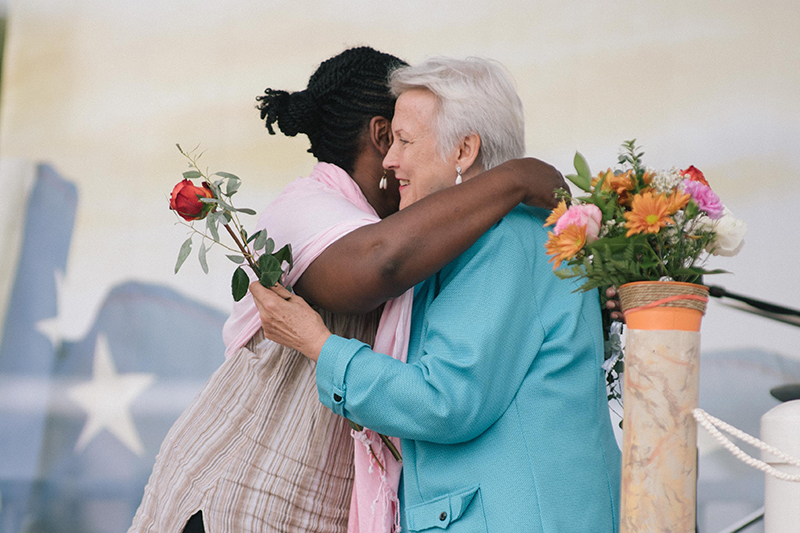Restorative Justice and Faith

UPF webinar says faith-based organizations essential in healing victims
Is restorative justice a means to healing?
In a world of both good and bad, it’s an important question experts around the globe are now asking.
Restorative justice is an approach to justice that emphasizes repairing the harm between a victim and an offender by organizing a meeting between them, sometimes including representatives of the wider community.
Family Federation for World Peace and Unification (FFWPU) and Universal Peace Federation (UPF) co-founder Dr. Hak Ja Han Moon, affectionately known as the Mother of Peace, has long sought to bring peace and reconciliation to the world through a wide range of global initiatives.
Now, the Coalition of Faith-Based Organizations (CFBO), where UPF is a founding partner, recently held an international web conference on restorative justice—which scholars and faith leaders alike say can help bring healing to individuals and, by extension, humanity.
Dr. Thomas Walsh, UPF chairman and CFBO co-chair, hosted the webinar Restorative Justice, Victim Assistance and Faith-Based Organizations on October 5, where nearly a hundred people from more than 30 countries participated, including dozens of experts in related fields.
“The value of restorative justice in the criminal justice system is an important means to facilitate healing in both victims and perpetrators,” said Dr. Walsh. “Consistent with victims’ and perpetrators’ rights, faith-based organizations should help forge approaches that bring victims and perpetrators together to facilitate healing.”
“Practices and programs grounded on the values and processes of restorative justice can be very appropriate when healing wrongs,” added Dr. Robert Peacock, president of the World Society of Victimology.
Dr. Peacock, also a professor at the University of Free State in South Africa and moderator of the webinar’s panel discussion, said processes and programs to facilitate healing should seek to represent victims’ interests as a priority. Additionally, they should include faith-based values of dignity, compassion, respect, universal interconnectedness, and reconciliation.
Healing wrongs are necessary on a personal and public scale, according to Dr. Peacock, where in turn, healed individuals can have a healing influence on their families, communities, and society at large.
Four panelists weighed in on restorative justice—particularly involving children and youth—and the role of faith-based organizations in such an undertaking.
“About 66 percent of young victims within the Catholic Church have reported abuse and trusted the institution to handle the issue,” said panelist Dr. Daniela Bolivar Fernandez, assistant professor at Catholic University of Chile’s School of Social Work. “Many have been let down and this should be rectified. But before this can occur, there needs to be investigation, response, and reform that centers on the victims of abuse.”
Panelist Dr. Tali Gal, senior lecturer and head of the School of Criminology at the University of Haifa in Israel, addressed the risks and challenges of using a restorative justice approach with children.
“Re-encountering the perpetrator can be traumatic for a young person,” said Dr. Gal. “They can feel pressured, manipulated, and intimidated by involving more adults to address the problem.”
However, Dr. Gal gave a brief outline of the framework for restorative justice and the complex relations between the rights and needs of victims and offenders, identifying a key point of giving the victim space to be an active partner in the process. She also pointed out that victims who come forward rarely regret doing so.
Still, in many cases the very concept of victimhood is problematic.
Dr. Fernanda Fonseca Rosenblatt, another panelist and professor at the International Institute for Restorative Practices (IIRP) in Bethlehem, Penn., shared about restorative justice and the concept of victimhood in places like South America.
“The victim–offender binary is problematic in many cases, especially in situations in economically-challenged countries,” said Dr. Rosenblatt. “Restorative justice can fail to account for context and complexity. We need a framework that accounts for complexity and can approach situations where the victim and offender are not clearly defined. Restorative justice can only move forward when the offender makes a positive commitment to the process and admits culpability.”
Further complicating the matter of restorative justice, faith-based institutions have also been involved in wrongdoing, despite espousing human rights values.
“I think faith-based organizations can start small by applying restorative justice within their own institutions and advocating for the application of restorative justice in their communities,” said panelist Dr. Michael O’Connell, secretary general of the World Society of Victimology.
“Faith-based organizations are also in a unique position to offer support to victims,” he said. “So now, and into the future, faith-based organizations have much at stake—and much to contribute to restorative justice.”
As co-founder of the Unification movement, Dr. Moon has largely focused on repairing and restoring humanity’s relationships through avenues of worldwide reconciliation like global Peace Starts With Me rallies and the international Peace Road movement.
In similar measure, CFBO is exploring how to bring the healing efforts of faith-based organizations into the justice sphere.
The CFBO webinar is part of an ongoing series. You can watch the full recording here.
Comments are welcomed and encouraged on this site, but there are some instances where comments will be edited or deleted. Please see our comments policy here.

angelika selle
| #
Btw this photo is from a wfwp Bridge of Peace eventbin WDC!
Reply